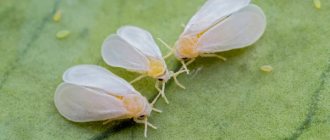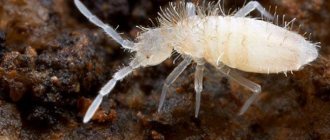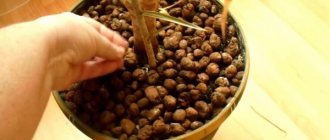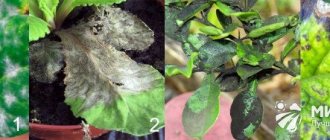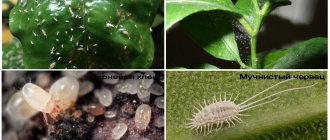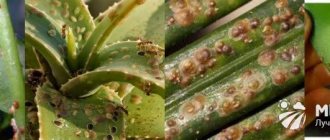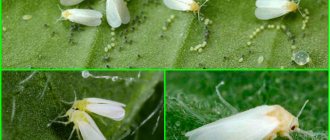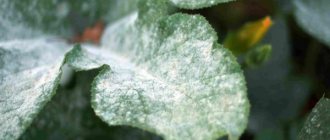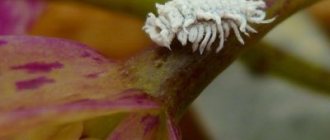Podury: photo
Fools: photo.
Description of the pest
Name: Real fools Lat.:
PoduridaeClass: Springtails - Collembola Order: Springtails - Poduromorpha
| Habitats: | indoor plants, garden and vegetable garden |
| Dangerous for: | colors |
| Means of destruction: | Fufanol, chemicals, decoctions |
Podura: photo.
Poduras are similar to small caterpillars. Color white or cream. Very rarely they are greenish or silvery. Body length is about 2 mm. Sometimes the length reaches 1 cm. The body has an oval shape.
Thanks to a special fork, they jump perfectly, pushing off with its help. This is what distinguishes the insect from the mealybug. When at rest, the organ is hidden under the abdomen.
The eggs are round in shape. The color is greenish-yellow with shine. After laying, larvae identical to adult individuals appear within 18–20 days. The larvae pose the same danger to flowers as the adults.
Very often, fools are confused with springtails, which live in indoor plants. In order not to be confused, we will continue to consider insects and pests of indoor plants.
Effective methods of control
The main thing is to figure out why springtails appeared at home, in open or closed ground.
The main reason is excess soil and air moisture. To combat pests, you will have to eliminate the factors that attract insects. How to proceed:
Folk remedies and recipes
It is not difficult to repel pests from orchids, violets, and camellias when using natural ingredients. Flower growers share their secrets of fighting tiny parasites.
Proven methods:
potato bait. The method is simple: divide the raw tuber into two halves, place the potatoes cut side down, and check the trap after 3-4 hours. Tiny insects actively gather around potatoes. The owners should quickly cover the piece of tuber with a bag or glass and remove the container along with the insects
It is important to act quickly, carefully, and remember: springtails on orchids, gloxinias, azaleas do not stay in one place for a long time, they jump to a new area,
wood ash against poisons. A good remedy for reducing the number of pests and reducing soil moisture
Directions for use: spread ash no more than 1 cm over the soil surface, reduce watering, reduce air humidity to optimal levels. For azaleas and camellias that prefer soils with high acidity, you should not use a natural component.
Preparations to combat springtails
Traditional methods are effective and safe for plants, but when the colony is large, potato baits and sprinkling the soil with wood ash do not give the desired result. Parasites actively gnaw at the roots, suck out the juices, and the plant weakens before our eyes.
In a difficult situation, it is important to treat the flower with proven drugs in a timely manner. Find out how to remove food moths from the kitchen using folk remedies and chemicals. Find out how to remove food moths from the kitchen using folk remedies and chemicals
Find out how to remove food moths from the kitchen using folk remedies and chemicals.
How to provide first aid and how to treat allergies to insect bites is written on this page.
Go to https://parazitam-stop.com/sad/rastenija/kapustnitsa.html and read about the reasons for the appearance and rules for controlling the cabbage butterfly in the garden.
Effective compositions for combating springtails:
Dimilin. Low-toxic product, active ingredient – diflubenzuron 250 g/kg. Broad-spectrum insecticide, insect growth regulator. Release form: wettable powder. A new generation drug with a residual effect of up to 40 days. The product is safe for people and animals (you should still not forget about measures to protect the skin, respiratory organs, and eyes), and quickly decomposes in water and soil. Regent. The product contains the active component fipronil, which disrupts the transmission of nerve impulses, causing paralysis in harmful insects. A contact-intestinal insecticide destroys a colony of pests in a few days. The drug is sold in two forms: ampoules with concentrated liquid and powder
When processing the soil, be careful; be sure to protect your eyes, respiratory organs, and skin from drops of the solution. Bazudin
A long-acting drug protects plants from many soil pests
Bazudin. A long-acting drug protects plants from many soil pests
Active substance – diazinon, 100 g/kg. A hazard class 3 product with a pungent odor. Granules have a complex effect on parasites and pests. To kill insects in flowerpots with indoor flowers, dig granules to a depth of 1 cm. Podurs die within a day after using the drug, the residual effect lasts up to six weeks. A contact-intestinal insecticide with translaminar action does not harm plants.
Common types
The parasite population depends on the humidity level. High humidity promotes active reproduction. Among the most common varieties, it is worth highlighting several main ones.
White . Living in the upper layer of the earth. Favorite places are greenhouses and greenhouses.
Vegetable . Eats ornamental crops and garden plants.
Mushroom . It feeds on young vegetative organs of plants and seedlings.
Fighting methods
Folk remedies
How to get rid of fools at home? If a small number of poduras appear in the substrate, do not rush to use chemical plant protection products; they can cause more harm to the orchid than a few insects.
When pests appear, the orchid should first of all:
- Isolate to prevent the spread of dura to other plants;
- Mechanical soil cleaning is carried out.
Good results can be achieved:
- Laying out bait in the form of raw potatoes cut into pieces on the substrate around the plant. In a few days, a large number of springtails will accumulate on it, which are easy to collect and eliminate;
- When immersing a flower with a pot in water for 20 minutes. All adult individuals will float to the surface in the water, after which they are collected and destroyed.
In addition, there are a number of other home methods to combat these insects.
Herbal decoctions of medicinal herbs. These decoctions have long been prepared to combat various harmful insects:
- Flowers of chamomile, calendula, dandelion, yarrow. To prepare a decoction, add 0.5 liters of water to 20 g of dry plants, bring everything to a boil and remove after ten minutes. Cool at room temperature, filter and treat the affected plants;
- Infusion of marigolds. Faded marigolds along with the leaves are poured with hot water in a 1:1 ratio and left for two days.
After treating the orchid with herbal decoctions, you should record the date of spraying in order to repeat the procedure after 7-10 days.
Herbal infusions are made against fools.
You can also use other solutions:
- Mustard solution. To prepare the solution, mustard powder (15 g) is poured into 1 liter of hot water and infused for 2 days. The resulting preparation is sprayed onto the plant, and dry mustard is sprinkled onto the soil;
- Mulching the soil with birch wood ash. A good result in the fight against springtails is obtained after sprinkling the soil with wood ash (birch ash is best) in a layer of one or two centimeters;
- Anti-flea shampoo for animals. A solution with the addition of flea shampoo showed unexpected effectiveness. To prepare 1 tbsp. l. shampoo is dissolved in a bucket of water, the plant and substrate are sprayed. After a short time after treatment, the orchids disappear.
The listed measures, which are used individually or in combination, are sufficient to protect indoor plants from any number of springtails.
Fitoverm
Fitoverm is a natural pesticide that is obtained during microbiological cultivation of the producing fungus. The drug is environmentally friendly, as a result of which its effect on the orchid will be minimal:
- The insect absorbs the drug along with food, as a result of which the poison affects only mature individuals and larvae. Podura eggs remain viable after treatment with phytoverm, so after 6-7 days it is necessary to spray again;
- Fitoverm is not mixed with other insecticides or fungicides.
To spray an orchid, 2 ml of the drug is dissolved in 50 ml of water, 0.1 liter of solution is consumed per plant.
Chemicals
If it was not possible to get rid of the larvae and adults using the methods described above, then you should use chemicals. Currently, there are a number of agents that have shown effectiveness against springtails:
- Bazudin is a powdery product; a thin layer of it is scattered over the surface of the substrate. As a result, after just a few hours, springtails will no longer annoy the plant;
- Pochin - used similarly to bazudine. To increase the efficiency of the process, the scattered preparation is mixed with a small amount of earth;
- Aktara is a universal drug, used in the form of a solution, which is used to water the soil and dilute it according to the instructions;
- Mospilan is also used to treat soil against podura in the form of a solution.
Chemical agents effectively help in the fight against fools.
These drugs will help control pests in a short time.
Precautionary measures
When working with insecticides, it is necessary to comply with safety rules:
- Children and pets are not allowed near the sprayed orchid;
- Work with insecticides is carried out with gloves and a respirator;
- After finishing work, the tools are thoroughly washed and stored in a separate place;
- In case of contact with skin, the insecticide is washed off with water and detergents. If the product gets into the eyes, rinse with running water;
- It is prohibited to eat or drink while carrying out work.
Used ampoules or packaging are wrapped in polyethylene and thrown away, the remaining solution is poured down the drain.
Reasons for the appearance of dupes
A small number of insects are always present in the soil of indoor plants, greenhouses, and especially open areas. They cause harm in large numbers. The appearance of parasites on ornamental plants is associated with:
- high humidity due to disruption of the irrigation system - watering should not be abused;
- increased level of moisture in the room - a damp microclimate contributes to the invasion of insects;
- the development of putrefactive processes - this refers to black tea leaves that rot, and to stagnation of moisture. They need to be removed;
- non-compliance with certain temperatures;
- weakened immune system in a calm state;
- the presence of moss in the container;
- violation of care - fallen leaves rot and attract fungi and parasites.
Mechanical methods of struggle
Poor quality care, accumulations of dried leaves and excess moisture create ideal conditions for the growth of houseplants. Therefore, to eliminate pests, it is necessary, first of all, to regulate watering, which is the main cause of increased soil moisture. Deprived of their usual and comfortable living conditions, springtails will no longer disturb the plant.
There are other ways to get rid of the fool:
It is very important to comply with indoor humidity levels. To do this, you should ventilate the room more often, dry clothes outside, and provide access to sunlight. A special device that absorbs excess moisture will help regulate the humidity level. Sprinkling the soil with ash or sand is one of the most effective methods of killing podura. It can be used for almost all plantings. The exception is plants growing in acidic soil. These include camellia, gardenia or azalea. To get rid of pests, it is enough to place the pot with the plant in water. After that, all that remains to do on its surface is to collect the floating springtails. Particular attention should be paid to the drainage system. After all, it is the clogging of the holes at the bottom of the flowerpot that causes water to stagnate. A few pebbles, which are placed on the bottom of the pot when replanting the flower, will help to avoid this. Replacing the substrate is another effective method to get rid of springtails
It is important not only to remove the contaminated soil, but also to thoroughly rinse the root system. You should also not use organic fertilizers too often. Residues of tea leaves or ground coffee can cause the development of mold or mildew, so they are added to the soil no more than once a week
After 2-3 days, the organic particles are removed and the substrate is carefully loosened so that the soil is enriched with oxygen. It is important to eliminate all factors that contribute to soil decay and mold. There is another original folk method of getting rid of the fungus, which is safe both for the plant and for the person himself. To do this, you will need a raw potato, which is cut into two parts, each of which is placed cut side down on the substrate. If you lift these halves after a few hours, you will see a lot of pests on them. After which the bait should be shaken off or washed off with water and the “bait” should be installed again.
